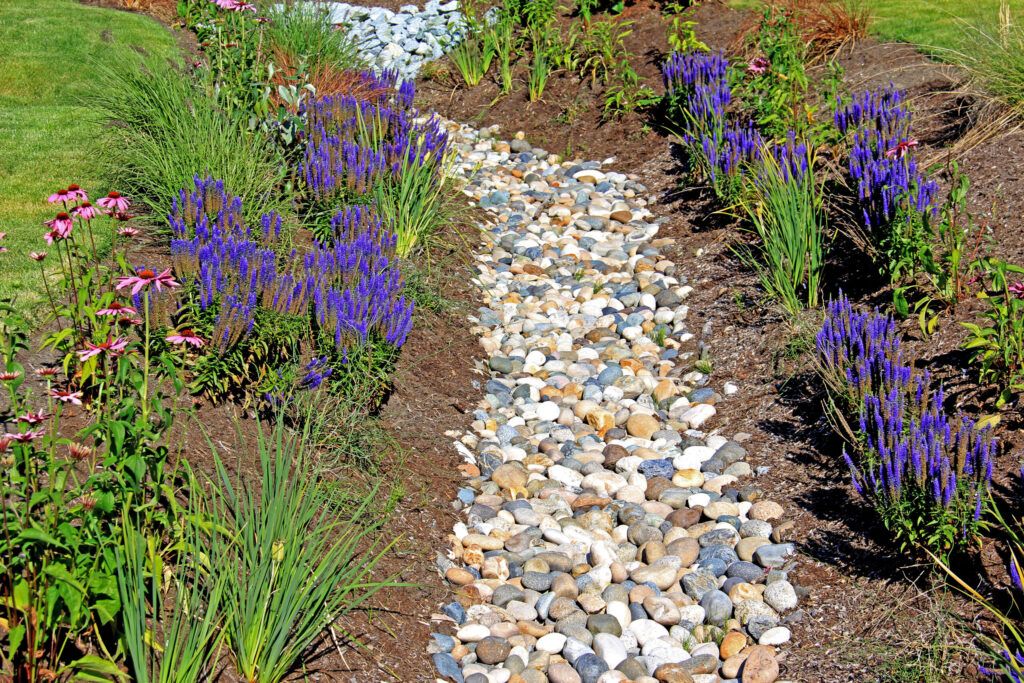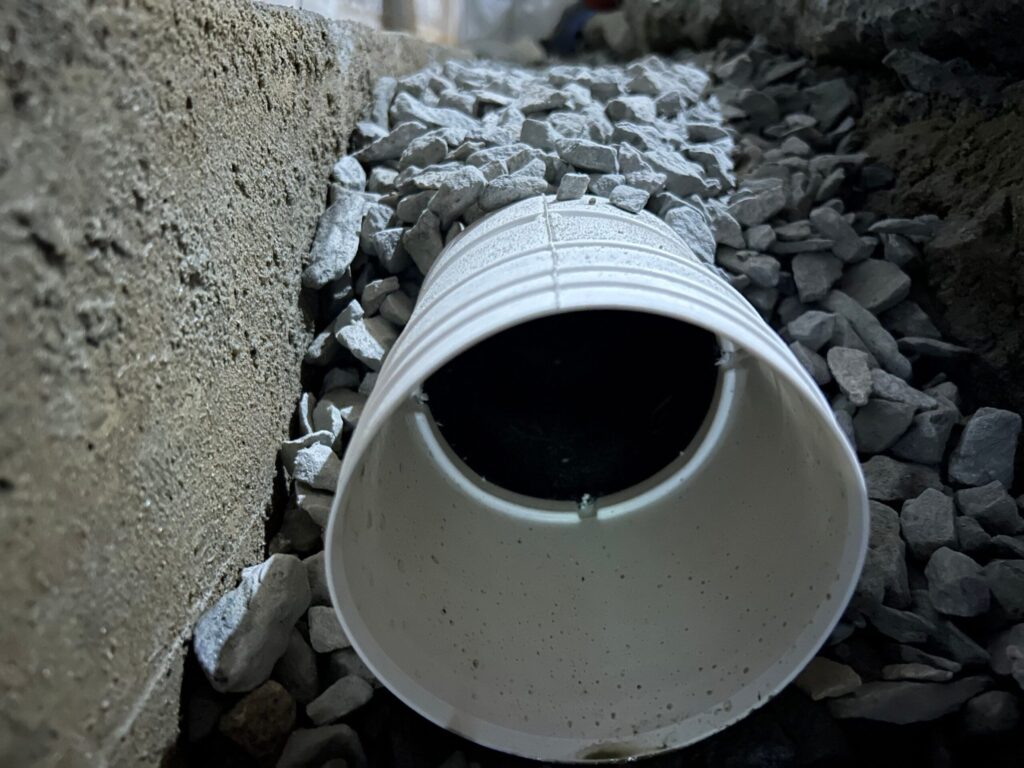Can You Use Landscape Fabric for French Drain? Get the Facts
Thinking about using landscape fabric for a French drain? You’re not alone. It’s a common question for homeowners tackling drainage issues.
In this quick guide, we’ll break down if it works, when it doesn’t, and what you should use instead to keep your yard draining properly.
Can you use landscape fabric for a French drain?
You can use landscape fabric for a French drain, but it may clog over time. Non-woven geotextile fabric is a better choice for long-term drainage performance
Key Takeaways
- You can use landscape fabric in a French drain, but it’s not the best option.
- Landscape fabric may clog over time, reducing water flow.
- Non-woven geotextile fabric is better for drainage and longevity.
- Wrapping gravel (not just the pipe) and using a proper slope helps your drain work efficiently.
What Is a French Drain?

A French drain is a gravel-filled trench with a perforated pipe that redirects excess surface water or groundwater away from problem areas. It’s commonly used to prevent flooding in yards or basements.
How Does a French Drain Work?
Water flows into the gravel trench and enters the perforated pipe through its openings. The pipe then channels the water to a designated drainage point, such as a storm drain or swale. This helps reduce hydrostatic pressure on soil and foundations, protecting against water damage.
What Is Landscape Fabric?
Landscape fabric is a porous material used in gardening and landscaping to block weeds while still letting water and air pass through.
It’s typically made from woven or non-woven polypropylene or polyester. These fabrics help keep soil in place and reduce erosion.
People often use it under mulch or gravel to prevent weed growth. It’s also used in drainage setups, but not all types are suited for high water flow.
When used correctly, landscape fabric can save time on maintenance and keep your yard looking clean. Choosing the right type is key for long-term performance.
Pros of Using Landscape Fabric in a French Drain
1. Keeps the Drainage System Clean
Landscape fabric acts like a gatekeeper for your French drain. It lets water through but keeps the junk out—think dirt, silt, and debris that love to clog things up. Without it, your drain’s basically a party invite for mud and mess. With it, the system stays clear, and water flows like it should.
2. Boosts Longevity Without the Drama
No one’s hyped to dig up a clogged drain six months in. Wrapping your gravel and pipe in fabric helps everything last longer. It’s like putting your kicks in a dust bag—protects the goods, saves you money later.
3. Makes Maintenance Way Easier
Once it’s in, landscape fabric keeps things tidy underground. Less sediment buildup means fewer surprises when you go to check on your system. It’s not exactly “set it and forget it,” but it’s close.
4. Plays Nice with Roots
Roots are sneaky. But fabric throws a subtle block, discouraging them from creeping into your drain like uninvited guests. It won’t stop the big guys, but it helps manage the smaller ones without making a fuss.
Cons of Using Landscape Fabric in a French Drain

1. Clogs Up Faster Than You’d Think
Landscape fabric might look like a good filter, but it doesn’t stay that way for long. Dirt, clay, and sediment sneak in and build up fast. Once it clogs, your drain stops draining and starts backing up. Not exactly the water-flow flex you were going for.
2. Doesn’t Hold Up Over Time
This stuff isn’t built for the long haul underground. It can tear or shift over time, especially if you’re working with gravel and water pressure. Once it shifts, it messes with the whole setup and can send water where you don’t want it.
3. It Traps Water Instead of Moving It
The goal of a French drain is flow. But when fabric gets gunked up, it holds moisture instead of moving it. That’s like putting a cork in your drainage system. Your yard stays soggy, and you’re left wondering what went wrong.
4. Better Alternatives Exist
If you want your French drain to work like a cheat code for yard drainage, look into non-woven geotextile fabric. It filters without clogging as fast, and it’s made for this kind of gig. Basically, it’s the pro move. Landscape fabric? That’s amateur hour.
Best Practices for Using Landscape Fabric in French Drains
Start with the right fabric. You want a non-woven, permeable type—not the stiff stuff used under mulch beds. It lets water flow through while blocking soil from clogging the pipe.
Wrap it smart. Line the trench with the fabric first, then pour in a few inches of gravel. Lay your perforated pipe, add more gravel, and fold the fabric over like a burrito. That keeps debris out without choking the flow.
Skip the shortcuts. Don’t use plastic sheeting or weed barrier fabric. Those trap water and mess with drainage. Stick with materials that actually do the job.
Lastly, don’t overthink it. Good fabric, clean gravel, and a proper slope are your cheat codes. Keep it simple and your drain won’t ghost you when the next big storm hits.
Landscape Fabric vs Drainage Fabric: What’s the Difference?
1. Landscape Fabric
Landscape fabric is meant to block weeds while still allowing some water through. It’s great for garden beds but not ideal for managing heavy water flow.
2. Drainage Fabric
Drainage fabric is made for water movement. It filters out soil and debris while letting water pass freely, which helps prevent clogs in French drains.
3. Which One Should You Use?
For a French drain, always go with drainage fabric. It’s designed to keep your system flowing and avoid blockages—something landscape fabric just can’t do well.
Alternatives to Landscape Fabric for French Drains

1. Gravel and Filter Fabric Combo
Old-school but solid. Instead of landscape fabric, try a layer of filter fabric specifically made for drainage systems. It wraps around the pipe and gravel like a burrito, keeping dirt out without choking water flow.
2. Washed Stone with No Fabric
Going fabric-free? Use clean, washed stone. Just know you’ll need more depth and better slope to keep things draining right. It’s a bit more “freestyle,” but it works if your soil drains fast and doesn’t clog easy.
3. Sock-Wrapped Drain Pipe
Some pipes come pre-wrapped in a mesh sock. Super plug-and-play. It filters debris right at the pipe, no extra fabric or fuss needed. Great for quick installs and lazy weekends.
If you have any doubts, simply get our service of French Drain Cleaning in Key Biscayne or Pompano Beach, and we’ll help you out.
Frequently Asked Questions
1. Can I use regular landscape fabric in a French drain?
Yes, but it’s not ideal. Regular landscape fabric can clog over time. For better results, go with non-woven geotextile fabric—it lets water pass through while keeping debris out.
2. What happens if I skip fabric in my French drain?
Without fabric, your drain can clog with dirt and silt. That means water won’t flow properly and the system could fail faster than expected.
3. Is woven or non-woven fabric better for a French drain?
Non-woven fabric is the better choice. It’s more porous and flexible, allowing steady water flow while blocking sediment.
Conclusion
Using landscape fabric for a French drain can work, but it’s not always the best long-term solution. It’s great for basic weed control but may clog over time when used around drainage gravel.
For better results, stick with non-woven geotextile fabric. It lets water through without letting in fine particles that can ruin your drain’s flow. This small switch can save you from future headaches.
If you’ve already used landscape fabric and notice poor drainage, consider replacing it before bigger issues pop up. Taking time to choose the right material upfront makes a big difference. When in doubt, go with what keeps the water moving and your yard dry.
